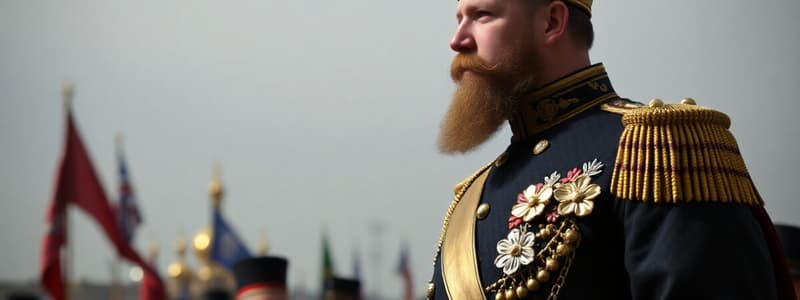Podcast
Questions and Answers
What percentage of the population in the Russian Empire was engaged in agriculture at the beginning of the twentieth century?
What percentage of the population in the Russian Empire was engaged in agriculture at the beginning of the twentieth century?
- 65%
- 85% (correct)
- 50%
- 70%
Which of the following regions were included in the Russian Empire under Tsar Nicholas II in 1914?
Which of the following regions were included in the Russian Empire under Tsar Nicholas II in 1914?
- Finland and Poland (correct)
- Iceland and Greenland
- Ireland and Scotland
- Sweden and Norway
Which major religion was predominant in the Russian Empire during the reign of Tsar Nicholas II?
Which major religion was predominant in the Russian Empire during the reign of Tsar Nicholas II?
- Russian Orthodox Christianity (correct)
- Catholicism
- Protestantism
- Judaism
In which cities was industry primarily located in the Russian Empire during the early 20th century?
In which cities was industry primarily located in the Russian Empire during the early 20th century?
How did the agricultural production in Russia compare to that of France and Germany around 1914?
How did the agricultural production in Russia compare to that of France and Germany around 1914?
What percentage of the factory labor force was made up of women by 1914?
What percentage of the factory labor force was made up of women by 1914?
Which social group among workers considered themselves 'aristocrats' due to their skills?
Which social group among workers considered themselves 'aristocrats' due to their skills?
What was the maximum working day length in craft units and small workshops compared to factories?
What was the maximum working day length in craft units and small workshops compared to factories?
What was a common accommodation arrangement for workers?
What was a common accommodation arrangement for workers?
What were the primary owners of most land in the countryside?
What were the primary owners of most land in the countryside?
Flashcards are hidden until you start studying
Study Notes
The Context of the Russian Revolution
- By 1914, Tsar Nicholas II ruled the expansive Russian Empire, including modern-day Finland, the Baltic states, parts of Poland, Ukraine, and Central Asia.
- The Russian Empire was predominantly Russian Orthodox Christian, with other religious minorities present, including Catholics, Protestants, and Muslims.
Economic and Social Conditions
- Around 85% of the population relied on agriculture for their livelihood, significantly higher than in Western Europe, where this figure ranged from 40% to 50%.
- Russia was a major grain exporter, but industrial development was limited to specific areas like St. Petersburg and Moscow, with most production occurring in small craft workshops.
- Factory workers experienced long hours, often up to 15 hours a day, and faced poor living conditions, while women constituted 31% of the workforce and received lower wages than men.
The 1905 Revolution
- Initial protests erupted over working conditions and demands for an eight-hour workday, culminating in Bloody Sunday when a peaceful procession was violently confronted by police, resulting in numerous casualties.
- The uprising led to the establishment of a Duma (Parliament) and a temporary increase in trade unions and political activity, which the Tsar later suppressed.
Impact of World War I
- The start of WWI in 1914 caused severe strain on Russia's economy due to labor shortages and disintegration of industrial infrastructure, further exacerbating food shortages in urban areas by 1916.
- The war effort prioritized military supplies, contributing to scarcity in civilian food stores and widespread unrest.
The February Revolution of 1917
- By February 1917, Petrograd faced harsh winter conditions and food shortages, leading to widespread strikes and protests from workers.
- A lockout in one factory sparked a sympathy strike with workers from fifty others joining in, escalating the situation against the Tsar’s regime.
- The Provisional Government, emerging from the revolution, struggled to maintain authority against rising Bolshevik influence and public discontent.
Bolshevik Strategy and Rising Tension
- Lenin's "April Theses" called for radical shifts within the Bolshevik Party, advocating for a socialist revolution despite initial skepticism from party members.
- Throughout mid-1917, worker and soldier committees formed, challenging factory management and demanding political changes while trying to seize power from the Provisional Government.
- The Provisional Government's attempts to restore order were met with protests and arrests of Bolshevik leaders, leading to increased tension and violence in the country.
Peasant Movements
- Peasants also pushed for land redistribution, encouraged by Socialist Revolutionary leaders, leading to seizures of land between July and September 1917.
Key Events of 1917
- The ‘July Days’ demonstrated the lengths to which the Bolsheviks would go to mobilize workers, resulting in government repression and the flight or hiding of key leaders.
This timeline of events and social dynamics sets the stage for understanding the complexities and catalysts of the Russian Revolution.
Studying That Suits You
Use AI to generate personalized quizzes and flashcards to suit your learning preferences.





